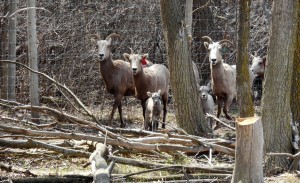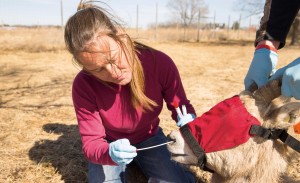SDSU working to help bighorn sheep herds recover from pneumonia outbreaks
Outbreaks of bacterial pneumonia among bighorn sheep are not new. They’ve been happening for decades.

Ewes from a Nevada bighorn herd struggling with bacterial pneumonia lambed in April at the SDSU research facility.
But what worries wildlife managers is the disease’s persistence. Even five or 10 years after the initial outbreak, all of the lambs in some herds are dying.
Pneumonia is the No. 1 disease threatening bighorn sheep across the western United States and Canada, according to John Kanta ’99, regional wildlife manager for the South Dakota Game, Fish and Parks Department. He estimated that 80 percent of the Custer State Park bighorn sheep died in 2004.
“That herd is still struggling,†Kanta said, with only 30 individuals left and little or no lamb survival. Now, the Rapid City herd is experiencing losses due to pneumonia.
Distinguished professor Jonathan Jenks from the SDSU natural resource management department is part of a multi-institutional research team evaluating whether eliminating the “typhoid Marys†that persistently shed a pathogen called Mycoplasma ovipneumoniae can increase lamb survival.
Jenks’ experience with the Black Hills bighorn sheep along with the research facility at SDSU provide the ideal combination for this study, according to wildlife biologist Frances Cassirer of the Idaho Department of Fish and Game.
The three-year project, which is in its second year, is supported by 11 agencies in four states (see listing) including the U.S. Department of Agriculture National Institute of Food and Agriculture through Hatch and McIntire-Stennis funding.
Identifying shedders

Swabbing the nasal passages provides doctoral student Brandi Felts with evidence of whether this ewe is shedding Mycoplasma ovipneumoniae. This ewe is among a group from Oregon and Washington that tests negative for mycoplasma.
“We think some animals who survive the initial outbreak, recover and develop immunity, but not sterile immunity,†said Washington State University pathologist Tom Besser, who is collaborating on the project. He’s been working on epizootic pneumonia in bighorn sheep for 10 years.
“The pathogen is not deep in the tissues,†Besser noted. “It’s just sitting there on their nose hairs.†These animals keep the pathogen circulating within the herd.â€
“We have a lot of struggling populations, and this research is focused on managing those populations to recovery by removing these super-shedders,†added Cassirer, who spearheaded the experiment design.
Quantitative ecologist Daniel Walsh of the U.S. Geological Survey National Wildlife Health Center in Madison, Wisconsin, introduced Jenks to Cassirer and assisted in the study design. Walsh will provide statistical
support for the research project.
The project involves animals from herds in South Dakota, Washington, Oregon, Idaho and Nevada that have not recovered from pneumonia outbreaks. Jenks and Brandi Felts, a doctoral student from Tilden, Texas, separate each herd based on those that repeatedly test positive or negative for mycoplasma.
“Chronic shedders consistently shed the pathogen,†Jenks explained, so always test positive. Other sheep stay negative, despite exposure to the shedders. “Negatives are always negative.â€
Increasing lamb survival
Preliminary results are encouraging, Jenks noted. Last year when the negative Oregon and Washington ewes were segregated from the shedders, all lambs survived; all the offspring from the positive ewes died. This year Jenks and Felts have comingled the positives and negatives and predict that all lambs will die.
The same procedure will be used with herds from other states.
Though the primary objective is to document the impact of chronic shedders on lamb survival, the researchers will also explore what to do with what they call intermediates. These animals test positive for mycoplasma at times yet negative at others. For now, they are grouped with the shedders.
In addition to validating the intermediate classification, the researchers will assess whether these animals become mycoplasma-negative if they are moved away from the chronic shedders.
“If we can understand this disease better, we may be able to give state agencies methods of eliminating the epizootics,†Jenks said.
Cassirer said, “I hope this project will give us an alternative to either doing nothing or removing entire populations.â€
Kanta agreed: “It is vitally important that we understand the mechanisms of the disease. In particular, once it’s run its course, what can we expect for population dynamics?â€
“I‘m looking for strategies to manage wildlife—data from this study will give me the certainty I need to do that,†he added.
Christie Delfanian






